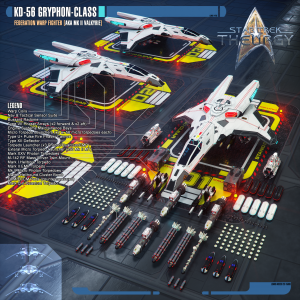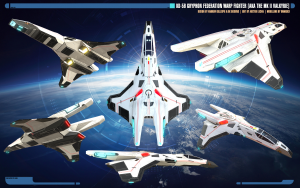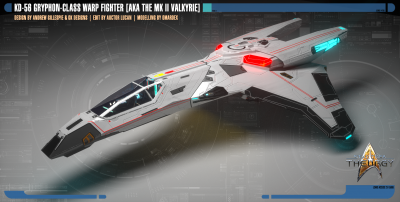AC-307 Mk II Valkyrie: Difference between revisions
From Star Trek: Theurgy Wiki
Auctor Lucan (talk | contribs) |
Auctor Lucan (talk | contribs) No edit summary |
||
| Line 51: | Line 51: | ||
| * (x1) Standard Pilot | | * (x1) Standard Pilot | ||
|- | |- | ||
| | | Warp & Impulse Speeds: | ||
| | | | ||
Warp | * Standard Speed: Warp 5.8 | ||
Warp | * Maximum Speed: Warp 7.6 | ||
* Maximum Cruise: 0.80 C | |||
* Combat Speed: 970 Km/s | |||
|- | |- | ||
| Tactical Specs: | | Tactical Specs: | ||
| Line 78: | Line 77: | ||
* Twin Tandem ITD-900 Series Class V Impulse Drive | * Twin Tandem ITD-900 Series Class V Impulse Drive | ||
* Standard RCS Thruster Assembly | * Standard RCS Thruster Assembly | ||
|- | |- | ||
| Other Systems | | Other Systems | ||
Revision as of 11:22, 5 July 2016
[UNDER CONSTRUCTION]
These are the space fighters the Lone-Wolves Squadron use in Star Trek: Theurgy.
Fighter Demonstration
Production History
At the success of the Mk II and the fleet-wide deployment of the Valkyries in the fleet, Starfleet Command began looking into the Valkyrie with more interest. Initially, they had considered Tactical CONN another spear in Starfleet's arsenal. So when the project was given new funding, R&D went back to the drawing board to see what could be improved on an already formidable weapon.
The first step was to increase the command, control and reconnaissance capabilities of the design. Originally, the Valkyrie (both Mk I and Mk II) employed an Isolinear twin-core design computer system, with 372 Isolinear banks and 106 command preprocessors and data analysis units. This design was quite successful for the use of standard comm traffic control and tactical targeting, but newer sensor package upgrades intended for the Valkyrie were hampered by a core that was already at its limit for processing power. So, with the eagerness of little boys with a new toy to take apart, R&D began a computer system redesign from the ground up, which would lead to hull, engine and weapons redesign, and end in an almost completely new Space Superiority attack fighter: the AC-409 Mk III Valkyrie.
By the time, Hyperjet Quantite Mk IV reactor cores were being successfully implemented in the experimental Knight-class interceptor. These core types could be sized variably (depending on the design requirements) while still maintaining a very high energy output. A twin-core design was drafted for the new Mk III, and projected numbers suggested the Mk III would see a 25% increase to power output than the Mk I & II series. With this increase in power output, a larger computer core system was designed. Utilizing bio-neural processors and relays, the original frame space needed for the computer systems was reduced, and spread out through the centreline of the craft. Computational capacity and storage was increased by another 30%, and a new tactical link-up library software system was implemented. The system provided a clearer and more accurate battlefield image the pilot, and the integration was so effective that the RIOs were not needed any more - only one pilot required in the cockpit.
With this new freedom of space within the spacecraft hull, R&D decided a more streamlined hull would benefit the pilot. Their new, sportier look reduced sensor cross-section and improved warp field stability for the twin quantite reactor cores. With the hull redesign came minor changes to weapons load-out: the arrangement of the standard Type-XII pulse phaser cannons and microtorpedo launchers in the Mk II changed only slightly to fit into the new spaceframe. The hard-point system was simplified, and the pulse phaser cell-magazine rack was switched from a vertical feed system to a horizontal feed system – this to combat original design flaws and jams during gravity-inducing combat manoeuvres.
Lastly, one more weapon was added: a tetryon pulse phase cannon was installed on the underside of the cockpit within its own hull compartment. This cannon was installed for ground suppression roles, and to give the Valkyrie an added punch in the Space Superiority role. The drawback to the tetryon pulse phase cannon was its limited ammunition and craft manoeuvrability when utilizing the weapon. Though the weapon itself could effectively neutralize enemy engine and weapons systems as well as due considerable kinetic energy damage, the weapon itself failed at a remarkable rate when engaged in combat manoeuvres. A straight-line course was required for the weapon to work effectively, limiting it to the dangerous Head-to-Head combat manoeuvre, and strafing of ground or orbital targets. With these weapon enhancements and increase in power, a slightly larger pair of shield generators were installed, increasing shield sustainable load to 390 isotons/second. The ablative armour was also thickened from 10.7 cm to 11.1 cm.
The top speed and warp capabilities of the Mk III remained virtually unchanged, but the increased power output from the new quantite cores benefited the improved avionics, sensor, weapons and shield systems more than her speed. Despite of this, the Valkyrie Mk III could easily go toe-to-toe with the fastest Interceptors currently in service. What she lacked in speed, she made up for in raw firepower. As of 2381, the Mk III Valkyrie remained a prototype test model, but with the recent development in intergalactic politics and the potential Romulan threat, the project was pushed towards immediate deployment by Aerospace Command. So, since the new Theurgy-class starship - the USS Theurgy - was not only being fitted with an A.I. inter-phase, but with a fully operational (if small) fighter assault bay, the decision was made. The Theurgy was given a complement of sixteen Mk III fighters with their own Squadron Commanding Officer and a crew of thirty technicians hailing from Starfleet Operations or Engineering Corps.
The sixteen pilots were named the Lone-Wolves, and though decimated to only twelve pilots after their escape from Earth, the survivors remain - fighting to preserve the truth of the corrupted Starfleet Command.
EXTERNAL HARD POINT OPTIONS (x4)
External hard points that are wing mounted. Before each battle, pick from the below list depending on availability.
ECM Pod/ECCM Emitter
Counter measures. ECM [Electric Counter Measure] is essentially is a micro torpedo full of shrapnel and debris with the given craft's transponder signature and sensor reading. It confuses the enemy ordinance and causes it to think the cloud of debris is the target. ECCM [Electric Chemical Counter Measure] creates a wake similar to a warp, impulse or thruster engine's wake, fooling such a guided missile into a false lock.
Additional Torpedo Launcher
Additional, wing-mounted torpedo launcher that can hold either 5 Mk XXVII photon torpedoes or 15 micro torpedoes. Recommended to mount two of these in order to balance the fighter properly.
Mk XXVII Photon Torpedo
Standard photon torpedo ordinance. Explosion is a matter-antimatter reaction producing large amounts of gamma waves as its primary means of destruction.
Mk Q-IV Quantum Torpedo
An improvement of the Mk XXVII photon torpedo with higher yield. A tactical quantum weapon, that utilize a plasma warhead and used casings similar in shape to photon torpedoes. The explosion leaves an antimatter residue and although they were powerful weapons, even a direct hit from a quantum torpedo might not destroy neutronium alloyed targets.
Mk I Hellborne Torpedo
Photon torpedo type weapon that results in a nuclear fission reaction, named for its use of standard nuclear radioactive bomb materials [Uranium, Plutonium etc.] The nuclear bomb detonates and this compresses hydrogen into helium creating a fusion reaction. Within the hydrogen core is a core of neutronium which the fusion reaction detonates. This detonation is equivalent 3 photon torpedo that detonate only a few moments after it contacts its target rather than detonating near the target, this because of the penetrate-and detonate-package in its casing. This weapon is highly ineffective against targets with fully powered shields. Against heavily armoured targets without any shielding left, this may be the only viable option that will punch through the heavy armour. The pilot can disable the penetrative package from the fighter to make one behave like a standard Tri-Nuclear Torpedo.
EMP Torpedo
Creates the electromagnetic pulse similar to what is created from the high atmosphere detonation of a nuclear warhead. A well shielded craft will withstand this easily but the weapon detonates in a burst of broadband, high-intensity electromagnetic energy, capable of disrupting magnetic fields and producing current or voltage surges in conductive materials via magnetic induction.
Hell Hound Cluster Bomb
Similar to the nature of a photon torpedo. Essentially, this is a photon torpedo stuffed with several micro torpedoes. The casing is opened upon a certain point releasing the small torps resulting in a large pattern of torpedo detonations.
EJECTION SYSTEMS
Escape Pod
All Valkyries are equipped with ejection modules or "pods". These allow for rapid emergency egress from the vehicle in case of danger. Linked to dedicated high speed processors, automatic sensors can detect certain types of danger and initiate an eject sequence automatically. This is especially useful if the pilot has been rendered unconscious through a blackout or other injury and the vehicle is in danger of crashing.
Modules have self-righting mechanisms in their base to assure a correct orientation during landing. Landing is accomplished by a single use anti-grav module. Free falling until they are 3 meters from the ground, the ejection seat/pod activates the AG module, which burns out as it lands the unit (relatively) gently. The pod remains pressurized with approximately 20 minutes of air, allowing a pilot time to completely seal his suit and activate his personal survival equipment. Once ready, the pilot has the option of discarding the pod by activating a manual release.
ETS [Emergency Transport System]
By the late 24th century, emergency transport was further improved through Starfleet's development of a single-person, single-use, one-way emergency transport unit. The device was small enough to be hand-held and could transport to specified coordinates with a single touch. Because of its extreme limitations, this device was not widely deployed and was still considered a prototype in 2379. [see Star Trek: Nemesis]
The Valkyries have built-in Emergency Transport Systems [ETS] in the cockpit - not the small prototype version - designated to the pilot and worn gear alone, with a one-way pre-set location for the USS Theurgy. The Emergency transporter can be reprogrammed to send the pilot to a new - by the pilot chosen - location because of the possibility of long-range missions, but this system is best utilised in the event of defending the Theurgy - being within Transporter range.



